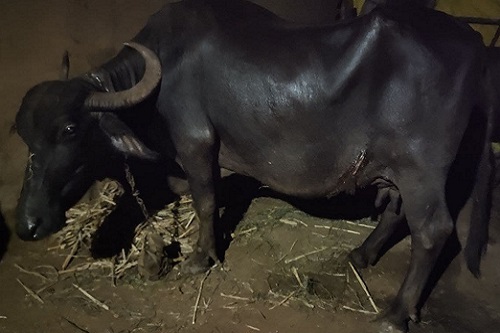Obstacles due to foetal monstrosities during parturition leads to dystocia and it is commonly observed in bovine. Dystocia due to dicephalus monster calf and its successful management by caesarean section has been reported earlier in crossbred cattle and in buffaloes . In the present communication the delivery of dead fetus carried out successfully by caesarian is documented in this paper.
Introduction
Dicephalus is a state of embryonic duplication, which involves the head with or without involvement of the neck. Dicephalus occurrence at birth is about one in one lac bovines . Duplication of cranial part of the foetus is more common than of the caudal parts, and it occurs due to imperfect duplication of germinal area forming partially or completely duplicated body structures. Double headed calf represent a case of absolute foetal monster which leads to dystocia. Such condition could be resolved through fetotomy or caesarean section . In the present case, two separate head attached to a single neck was noticed. In present report, the foetus was dead and two separate head were joined with single neck, so to save life of the buffalo caesarian was done followed by successful medical management of the dam.
Key words: Surti buffalo, Dystocia, Dicephalic monster, Caesarian

Case History and Clinical Findings
A primiparous Surti buffalo aged about 8 year referred to me with a history of parturient signs, lateral recumbency and continuous straining for over 6 hours at village Hemrajpura, Ta-Umreth,Di-Anand,Gujarat. The water bag had ruptured. Vulva was inflamed and odematous. Vaginal mucus membrane was dry and congested. At the time of presentation, the animal had normal physiological parameters. Per vaginal examination revealed complete cervical dilatation and presence of dead foetus in anterior presentation having double head separated with each other. Based on history, clinical findings and per vaginal examination a tentative diagnosis of dystocia due to foetal monster (double head) was made . Dystocia couldn’t be relieved by manual handling due to oversized foetus so decided for the caesarian section.

Surgical Procedure
Considering the severity of the case and urgency, decision was taken to perform caesarian in the recumbent position of the animal. Narcosis is hardly used and surgery under epidural and local infiltration anaeshesia is routine.In this case caesarean section was done in right lateral recumbancy .The animal is restrained in right lateral recumbency and after preparing a site sufficiently slight oblique long incision was given above the left subcutaneous abdominal milk vein .All layers of the abdominal wall were incised and the omentum was pulled cranially to expose gravid uterus.The uterus was incised along its greater curvature between the rows of caruncles .The foetus along with foetal membranes was then pulled out by traction on both the extended hindlimbs ensuring minimum damage to the uterus After relieving dystocia, six Furea bolus were placed in uterus. 5 to 6 litres of Normal saline, Inj. Dexona 5 ml,Inj. Calcium borogluconate 500 ml along with Antibiotic and Analgesics were given intravenous to the dam.After removal of the foetus . The serosal surface of the uterus was cleaned with saline to remove blood clots and fibrins.The uterine incision was then closed with a single row of cushing suture using absorbable suture material chromic catgut no.2. Peritoneum, Muscles and sub cutaneous tissues were sutured with catgut no.2 in a simple continuous suture pattern. The abdominal wound was then closed routinely.Skin was then sutured with non absorbable suture material cotton thread in horizontal mattress suture pattern . The buffalo recovered uneventfully following the treatment with parentral fluid, antibiotic (Inj. Ceftriaxone 6 g), Antihistaminic (Inj. Anistamin 10 ml) and Analgesic (Inj. Analgin 20 ml) for five consecutive days.Sutures were removed after 15 days.

Results
The buffalo is now recovered completely. Defecation, urination, feeding, milking and all other activities are normal as per self observation & owners description.

| The content of the articles are accurate and true to the best of the author’s knowledge. It is not meant to substitute for diagnosis, prognosis, treatment, prescription, or formal and individualized advice from a veterinary medical professional. Animals exhibiting signs and symptoms of distress should be seen by a veterinarian immediately. |






Be the first to comment